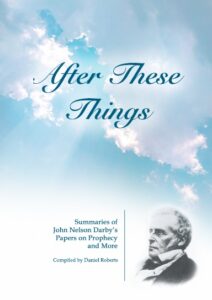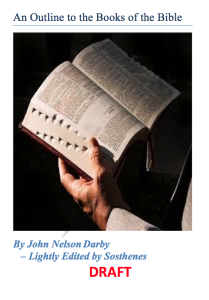 ‘After These Things’SECTION 4 – SIMPLIFIED SUMMARIES OF THE 1840 GENEVA LECTURES
‘After These Things’SECTION 4 – SIMPLIFIED SUMMARIES OF THE 1840 GENEVA LECTURES
From our book ‘After These Things – Summaries of John Nelson Darby’s Papers on Prophecy – and more…’ Compiled by Daniel Roberts. For more about this book click on the picture or CLICK HERE
The Present Hope of the Church –
Introduction
J N Darby gave a series of eleven significant lectures in Geneva in 1840 on the Present Hope of the Church (L’attente actuelle de l’église). These established his reputation as a leading interpreter of biblical prophecy, and the basis of dispensational and pre-millennial tribulation (or ‘pre-trib’) teaching. Central to this is the Rapture – Christ’s coming momentarily to call His own who are alive on the earth when the dead in Christ are raised. This is clearly described in 1 Thessalonians 4:13-18 and 1 Corinthians 15:51-52.
JND said as to prophecy: ‘In going through the more general features of prophecy, we shall examine these three great subjects: the church; the nations; and the Jews.’ (J N Darby Collected Writings vol 2, Prophetic 1, page 281). God made Himself known as ‘Jehovah’ (or more literally ‘Yahweh’) to the Jews, though many Jews consider this name too holy to pronounce. Jesus is presented as the Messiah, the centre of God’s promises and blessings to the Jewish nation. However, God presents Himself as ‘Father’ to the Church while Jesus is presented as the ‘Son of God’. We are His brethren – children of God and members of His family. He, the Firstborn, is the expression of all the glory of the Father.
‘…We also have a more sure word of prophecy; whereunto ye do well that ye take heed, as unto a light that shineth in a dark place, until the day dawn, and the day star arise in your hearts: knowing this first, that no prophecy of the scripture is of any private interpretation. For the prophecy came not in old time by the will of man: but holy men of God spake as they were moved by the Holy Ghost.’ ( 2 Peter 1:19-21.)
.
Summary of Lectures
- The Present Hope of the Church
- The Church and its Glory
- The Second Coming of Christ
- The First Resurrection – or The Resurrection of the Just
- The Judgment of Evil
- Ecclesiastical Apostasy and Civil Apostasy
- The Judgment of the Nations
- God’s Promises to Israel
- What God in His Goodness will yet do for Israel – and what it Means for Us
- The Remnant of Israel
- The Importance of Prophecy
JN Darby’s Lecture 1 on The Hope of the Church of God
The Christian’s Assurance as to Prophecy
Every Christian should not only be sure of his salvation in Christ, but also know its results. He should not only know he is in the Father’s house with all its privileges but be happy there too. In prophecy, God treats us as His friends, and reveals the things He is occupied with. As our hearts are associated with Him, they realise His love and confidence and are coloured by the expectation of what is to come. With this holy knowledge we are strangers and pilgrims here.
We need to distinguish between that which applies to the Jews, relating to the earth, and that which applies to the Church. Being free of human objects, cares and distractions we can be dependent on the One who knows the end from the beginning.
Whilst prophecy proves the divine source of the Bible, that is not its main purpose. Prophecy belongs to the Church now and the Jewish remnant in a future day, as a light or torch before things take place. God tells us the truth; Satan does not. Do we doubt God? Surely we do not need witnesses to persuade us that God is telling the truth.
Satan has deceived many by introducing the thought that partially fulfilled prophecies, were in fact complete. Most, if not all prophecy is to be fulfilled after the end of this dispensation. Then it will be too late to be convinced as to the truth. Those left behind will experience terrible judgment. But as I read God’s word, I am restful. I am enlightened as I cleave to Him instead of my own understanding. As things unfold I see the purposes of the Most High, opening up His character – His faithfulness, justice, long-suffering. But He will certainly judge proud iniquity and execute vengeance on these who corrupt the earth, in order for His government to be established in peace and blessing.
The judgment of God will come upon the nations; the church is informed of this; and, thanks to the teaching of the Holy Spirit, understands it, believes it, and escapes the things which are coming.
The Sceptic as to Prophecy
The sceptic views prophecy as merely speculative, vague and uninfluential, the imaginations and vainglory of proud hearts. The sceptic’s own thoughts are the most speculative. How Satan deceives! But prophecy reveals God’s thoughts as to things to come. And the Christian rejoices that “the earth shall be filled with the knowledge of the glory of the LORD, as the waters cover the sea” (Hab 2:14). And God will show how.
Communion with God as to Prophecy
Through communion, which is eternal, God comforts and sanctifies us to prevent our hopes being vague. Thank God “we have not followed cunningly devised fables, when we made known unto you the power and coming of our Lord Jesus Christ, but were eyewitnesses of his majesty. For he received from God the Father honour and glory, when there came such a voice to him from the excellent glory, This is my beloved Son, in whom I am well pleased. And this voice which came from heaven we heard when we were with him in the holy mount.
We have also a more sure word of prophecy; whereunto ye do well that ye take heed, as unto a light that shineth in a dark place, until the day dawn, and the day star arise in your hearts: Knowing this first, that no prophecy of the scripture is of any private interpretation. For the prophecy came not in old time by the will of man: but holy men of God spake as they were moved by the Holy Ghost.” (2 Peter 1:16-21)





